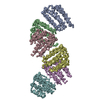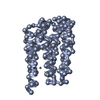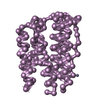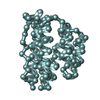+ Open data
Open data
- Basic information
Basic information
| Entry | Database: PDB / ID: 1rh2 | ||||||
|---|---|---|---|---|---|---|---|
| Title | RECOMBINANT HUMAN INTERFERON-ALPHA 2B | ||||||
 Components Components | INTERFERON-ALPHA 2B | ||||||
 Keywords Keywords | CYTOKINE / INTERFERON / ANTI-VIRAL / IMMUNOMODULATOR / 4 HELIX BUNDLE | ||||||
| Function / homology |  Function and homology information Function and homology informationtype I interferon receptor binding / B cell activation involved in immune response / natural killer cell activation involved in immune response / negative regulation of interleukin-5 production / negative regulation of interleukin-13 production / negative regulation of T cell differentiation / negative regulation of T-helper 2 cell cytokine production / T cell activation involved in immune response / host-mediated suppression of symbiont invasion / cell surface receptor signaling pathway via STAT ...type I interferon receptor binding / B cell activation involved in immune response / natural killer cell activation involved in immune response / negative regulation of interleukin-5 production / negative regulation of interleukin-13 production / negative regulation of T cell differentiation / negative regulation of T-helper 2 cell cytokine production / T cell activation involved in immune response / host-mediated suppression of symbiont invasion / cell surface receptor signaling pathway via STAT / TRAF6 mediated IRF7 activation / type I interferon-mediated signaling pathway / response to exogenous dsRNA / humoral immune response / Regulation of IFNA/IFNB signaling / cytokine activity / Evasion by RSV of host interferon responses / cellular response to virus / Interferon alpha/beta signaling / cell-cell signaling / : / Factors involved in megakaryocyte development and platelet production / defense response to virus / adaptive immune response / cell surface receptor signaling pathway / inflammatory response / negative regulation of gene expression / negative regulation of DNA-templated transcription / apoptotic process / SARS-CoV-2 activates/modulates innate and adaptive immune responses / extracellular space / extracellular region Similarity search - Function | ||||||
| Biological species |  Homo sapiens (human) Homo sapiens (human) | ||||||
| Method |  X-RAY DIFFRACTION / X-RAY DIFFRACTION /  MIR / Resolution: 2.9 Å MIR / Resolution: 2.9 Å | ||||||
 Authors Authors | Walter, M.R. | ||||||
 Citation Citation |  Journal: Structure / Year: 1996 Journal: Structure / Year: 1996Title: Zinc mediated dimer of human interferon-alpha 2b revealed by X-ray crystallography. Authors: Radhakrishnan, R. / Walter, L.J. / Hruza, A. / Reichert, P. / Trotta, P.P. / Nagabhushan, T.L. / Walter, M.R. | ||||||
| History |
|
- Structure visualization
Structure visualization
| Structure viewer | Molecule:  Molmil Molmil Jmol/JSmol Jmol/JSmol |
|---|
- Downloads & links
Downloads & links
- Download
Download
| PDBx/mmCIF format |  1rh2.cif.gz 1rh2.cif.gz | 37.7 KB | Display |  PDBx/mmCIF format PDBx/mmCIF format |
|---|---|---|---|---|
| PDB format |  pdb1rh2.ent.gz pdb1rh2.ent.gz | 22.3 KB | Display |  PDB format PDB format |
| PDBx/mmJSON format |  1rh2.json.gz 1rh2.json.gz | Tree view |  PDBx/mmJSON format PDBx/mmJSON format | |
| Others |  Other downloads Other downloads |
-Validation report
| Summary document |  1rh2_validation.pdf.gz 1rh2_validation.pdf.gz | 381.9 KB | Display |  wwPDB validaton report wwPDB validaton report |
|---|---|---|---|---|
| Full document |  1rh2_full_validation.pdf.gz 1rh2_full_validation.pdf.gz | 382 KB | Display | |
| Data in XML |  1rh2_validation.xml.gz 1rh2_validation.xml.gz | 1.5 KB | Display | |
| Data in CIF |  1rh2_validation.cif.gz 1rh2_validation.cif.gz | 8 KB | Display | |
| Arichive directory |  https://data.pdbj.org/pub/pdb/validation_reports/rh/1rh2 https://data.pdbj.org/pub/pdb/validation_reports/rh/1rh2 ftp://data.pdbj.org/pub/pdb/validation_reports/rh/1rh2 ftp://data.pdbj.org/pub/pdb/validation_reports/rh/1rh2 | HTTPS FTP |
-Related structure data
| Similar structure data | Similarity search - Function & homology  F&H Search F&H Search |
|---|
- Links
Links
- Assembly
Assembly
| Deposited unit | 
| ||||||||||||||||||||||||
|---|---|---|---|---|---|---|---|---|---|---|---|---|---|---|---|---|---|---|---|---|---|---|---|---|---|
| 1 | 
| ||||||||||||||||||||||||
| 2 | 
| ||||||||||||||||||||||||
| 3 | 
| ||||||||||||||||||||||||
| 4 | 
| ||||||||||||||||||||||||
| 5 | 
| ||||||||||||||||||||||||
| 6 | 
| ||||||||||||||||||||||||
| Unit cell |
| ||||||||||||||||||||||||
| Noncrystallographic symmetry (NCS) | NCS oper:
|
- Components
Components
| #1: Protein | Mass: 19277.033 Da / Num. of mol.: 6 Source method: isolated from a genetically manipulated source Source: (gene. exp.)  Homo sapiens (human) / Production host: Homo sapiens (human) / Production host:  #2: Chemical | ChemComp-ZN / Compound details | THE DISULFIDE BOND BETWEEN CYS 1 AND CYS 98 IS NOT OBSERVED. | |
|---|
-Experimental details
-Experiment
| Experiment | Method:  X-RAY DIFFRACTION / Number of used crystals: 2 X-RAY DIFFRACTION / Number of used crystals: 2 |
|---|
- Sample preparation
Sample preparation
| Crystal | Density Matthews: 3.1 Å3/Da / Density % sol: 60 % | ||||||||||||||||||||||||
|---|---|---|---|---|---|---|---|---|---|---|---|---|---|---|---|---|---|---|---|---|---|---|---|---|---|
| Crystal grow | Method: macroseeding / pH: 5.6 Details: PROTEIN WAS CRYSTALLIZED FROM 40MM ZINC ACETATE, 30MM CACODYLATE, PH 5.6; MACRO SEEDING WAS PERFORMED TO GET REASONABLE SIZE CRYSTALS., macroseeding | ||||||||||||||||||||||||
| Crystal grow | *PLUS Temperature: 23 ℃ / Method: vapor diffusion, hanging drop | ||||||||||||||||||||||||
| Components of the solutions | *PLUS
|
-Data collection
| Diffraction | Mean temperature: 103 K |
|---|---|
| Diffraction source | Source:  ROTATING ANODE / Type: RIGAKU RUH2R / Wavelength: 1.5418 ROTATING ANODE / Type: RIGAKU RUH2R / Wavelength: 1.5418 |
| Detector | Type: RIGAKU / Detector: IMAGE PLATE / Date: Dec 1, 1995 |
| Radiation | Monochromator: NI FILTER / Monochromatic (M) / Laue (L): M / Scattering type: x-ray |
| Radiation wavelength | Wavelength: 1.5418 Å / Relative weight: 1 |
| Reflection | Resolution: 2.9→6 Å / Num. obs: 31925 / % possible obs: 96 % / Observed criterion σ(I): 0 / Redundancy: 6.8 % / Rmerge(I) obs: 0.095 / Net I/σ(I): 10 |
| Reflection shell | Resolution: 2.9→3 Å / Redundancy: 3.9 % / Rmerge(I) obs: 0.24 / Mean I/σ(I) obs: 3.2 / % possible all: 92 |
| Reflection | *PLUS Num. measured all: 217393 |
- Processing
Processing
| Software |
| ||||||||||||||||||||||||||||||||||||||||||||||||||||||||||||
|---|---|---|---|---|---|---|---|---|---|---|---|---|---|---|---|---|---|---|---|---|---|---|---|---|---|---|---|---|---|---|---|---|---|---|---|---|---|---|---|---|---|---|---|---|---|---|---|---|---|---|---|---|---|---|---|---|---|---|---|---|---|
| Refinement | Method to determine structure:  MIR / Resolution: 2.9→6 Å / Rfactor Rfree error: 0.009 / Data cutoff high absF: 100000 / Data cutoff low absF: 0.1 / Cross valid method: THROUGHOUT / σ(F): 0.1 MIR / Resolution: 2.9→6 Å / Rfactor Rfree error: 0.009 / Data cutoff high absF: 100000 / Data cutoff low absF: 0.1 / Cross valid method: THROUGHOUT / σ(F): 0.1 Details: SIX MOLECULES IN THE ASYMMETRIC UNIT WERE REFINED WITH NCS RESTRAINTS WITH WEIGHT = 30 KCAL/MOL-(A)2 AND SIGB = 1.5 (A)2
| ||||||||||||||||||||||||||||||||||||||||||||||||||||||||||||
| Displacement parameters | Biso mean: 30.6 Å2 | ||||||||||||||||||||||||||||||||||||||||||||||||||||||||||||
| Refine analyze |
| ||||||||||||||||||||||||||||||||||||||||||||||||||||||||||||
| Refinement step | Cycle: LAST / Resolution: 2.9→6 Å
| ||||||||||||||||||||||||||||||||||||||||||||||||||||||||||||
| Refine LS restraints |
| ||||||||||||||||||||||||||||||||||||||||||||||||||||||||||||
| Refine LS restraints NCS | NCS model details: RESTRAINTS | ||||||||||||||||||||||||||||||||||||||||||||||||||||||||||||
| LS refinement shell | Resolution: 2.9→3.02 Å / Total num. of bins used: 8
| ||||||||||||||||||||||||||||||||||||||||||||||||||||||||||||
| Xplor file |
| ||||||||||||||||||||||||||||||||||||||||||||||||||||||||||||
| Software | *PLUS Name:  X-PLOR / Version: 3.1 / Classification: refinement X-PLOR / Version: 3.1 / Classification: refinement | ||||||||||||||||||||||||||||||||||||||||||||||||||||||||||||
| Refine LS restraints | *PLUS
|
 Movie
Movie Controller
Controller



 PDBj
PDBj






